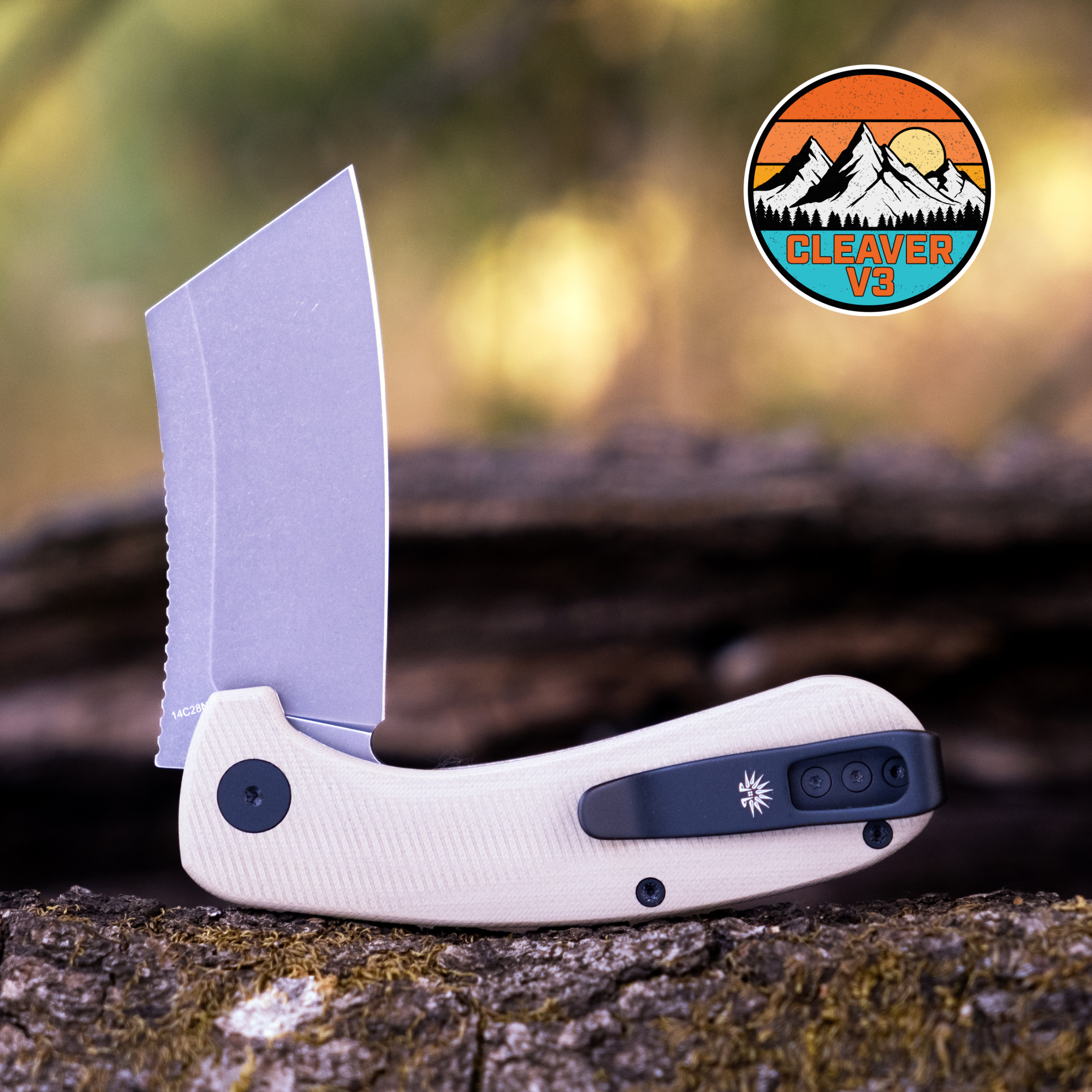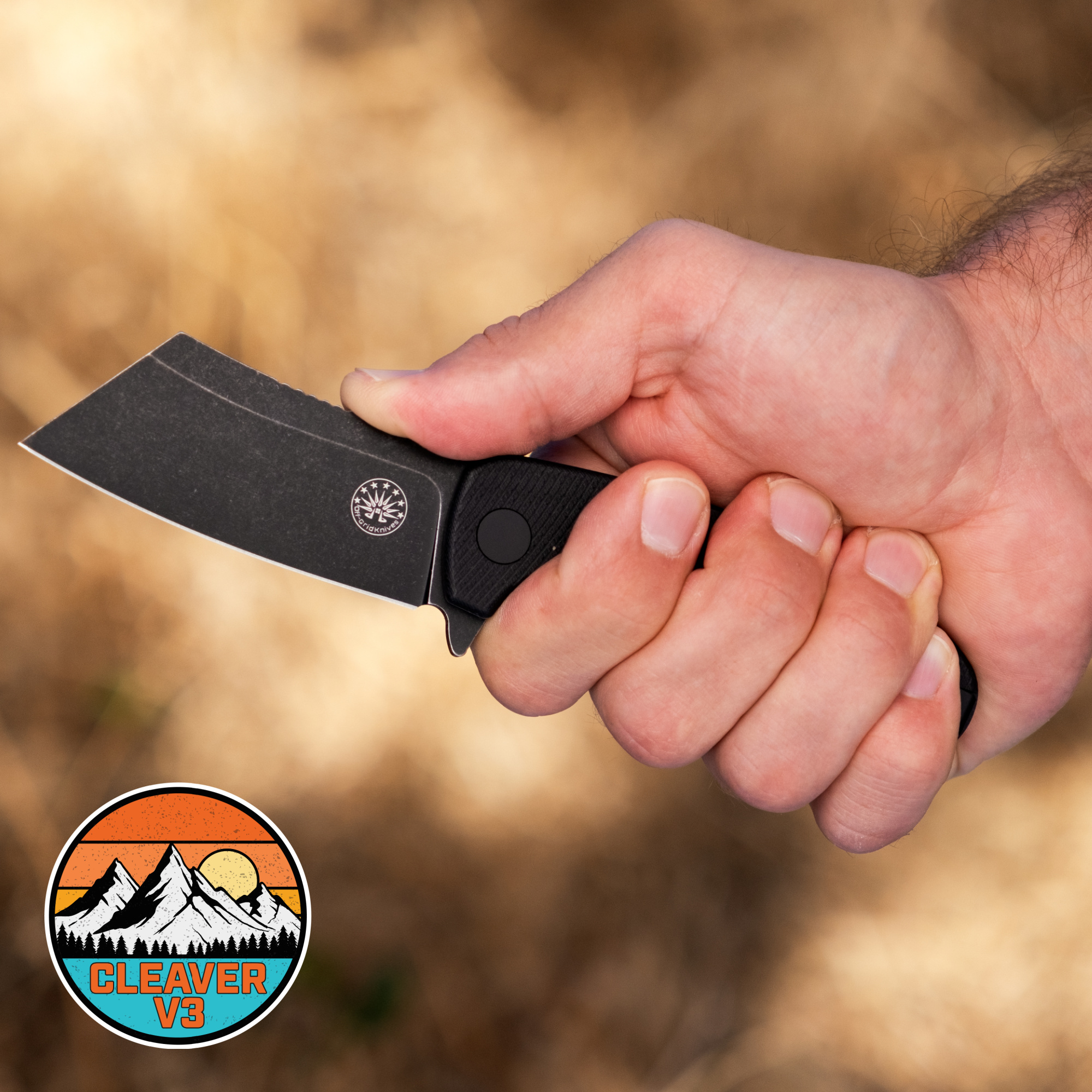What Is a Cleaver Knife and What Is It Used For?
Posted by Emran Hossen on Oct 25th 2025
What Is a Cleaver Knife?
A cleaver knife is a large, rectangular-bladed knife designed for heavy-duty cutting tasks. Traditionally used by butchers, it features a thick spine and weighted blade that make it ideal for chopping through meat, bones, and dense vegetables. Unlike standard chef’s knives, cleavers rely on force and momentum rather than finesse. Modern cleavers, like those from Off-Grid Knives, combine toughness with precision, making them versatile tools for both kitchen and outdoor use, including food prep, camping, and survival tasks.

Design Features of a Cleaver Knife
The functionality of a cleaver knife comes from its distinctive features:
- Broad, Rectangular Blade: Offers a large cutting surface for chopping, crushing, and scooping ingredients.
- Thick Spine: Provides durability and allows the knife to handle heavy impacts without bending or chipping.
- Full Tang Construction: Most quality cleavers, like Off-Grid’s, are built from a single piece of steel, ensuring strength and balance.
- Ergonomic Handle: Designed for a secure, comfortable grip during prolonged use, often featuring materials like G10 for durability and control.
- Beveled Edge: Maintains sharpness while offering enough heft to slice through tough materials cleanly.
Cleaver Knife Materials and Construction
The performance of a cleaver depends heavily on its materials:
- Blade Steel: Cryo D2 tool and Sandvik 14C28N steel are preferred for strength, corrosion resistance, and edge retention.
- Handle Materials: G10 handles (like those in Off-Grid models) provide superior grip, weather resistance, and durability.
- Full Tang Design: Offers maximum strength and stability by extending the blade through the handle.
- Blade Finish: Blackout or stonewashed finishes enhance corrosion resistance and add tactical appeal.
- Blade Length: A cleaver knife with a blade length between 3 and 6 inches is ideal for cutting tasks and delivers excellent performance.
What Is a Cleaver Knife Used For?
Here are the most common and practical uses of a cleaver knife:
- Chopping Meat: Perfect for cutting through thick cuts of meat, including pork, beef, and poultry.
- Breaking Bones: The weight and force of the cleaver make it ideal for splitting small to medium bones without damaging the blade.
- Cutting Through Joints: Easily separates meat from bone or divides large pieces at the joints with accuracy.
- Slicing Vegetables: Despite its heft, a cleaver can finely slice vegetables such as cabbage, onions, and carrots.
- Mincing Garlic, Ginger, or Herbs: The flat side of the blade helps crush and mince ingredients efficiently.
- Scooping Ingredients: After chopping, the wide blade can be used to transfer ingredients from the cutting board to a pot or pan.
- Crushing Food Items: The flat surface works perfectly for crushing nuts, peppercorns, or cloves of garlic.
- Tenderizing Meat: The blunt side can be used to pound and tenderize tough meat cuts before cooking.
- Cleaving Through Frozen Foods: A sturdy cleaver can handle frozen meat or thick, icy portions that ordinary knives can’t manage.
- Outdoor and Survival Tasks: Modern tactical cleavers, such as those from Off-Grid Knives, are excellent for camp cooking, chopping wood, and even light bushcraft.
- Food Presentation: Some chefs use the cleaver’s wide surface to flatten or shape food for plating and presentation.
- Cutting Tough Produce: It slices through hard vegetables like pumpkins, squash, or coconuts with ease.
- Precision Dicing: When handled skillfully, a cleaver can dice meat and vegetables evenly and quickly.
- Kitchen Efficiency: Its broad surface and multifunctional nature reduce the need for switching knives during food preparation.
- Self-Defense or Utility: Certain tactical cleaver knives are designed for EDC (Everyday Carry) use, combining functionality with personal safety.
Top Cleaver Knife Models by Off-Grid Knives
Here are some of their top-rated cleaver knife models that combine tactical strength with exceptional design.
Choosing the Right Cleaver Knife
Selecting the right cleaver depends on your specific needs — whether you’re a home cook, professional chef, or outdoor enthusiast.
- For Kitchen Use: If you mainly cook indoors, go for a cleaver with a balanced weight and sharp, thin edge — like the GRIZZLY V2 Chef Knife — for precise cutting and comfort during long sessions.
- For Butchering or Meat Prep: Choose a heavy-duty cleaver like the CLEAVER V3 – Blackout or CLEAVER V3 – Coyote, designed to handle dense meat, cartilage, and bone.
- For Outdoor and EDC Tasks: A compact fixed-blade model like the HOGLET is perfect for survival situations, camping, and everyday utility.
How to Maintain a Cleaver Knife
Proper maintenance ensures your cleaver knife performs flawlessly for years. Because cleavers are designed for heavy-duty work, they require consistent care to keep the blade sharp and corrosion-free.
- Clean Immediately After Use: Wash your cleaver with warm water and mild soap right after use. Avoid soaking it, especially if the blade is high-carbon steel, as it may lead to rust.
- Dry Thoroughly: Always dry the knife completely using a soft towel to prevent moisture damage or staining.
- Regular Sharpening: Cleavers require regular sharpening to maintain cutting power. Use a whetstone, honing rod, or professional sharpener to restore the edge. For heavy chopping cleavers, a slightly thicker edge angle (around 20–25 degrees) is ideal.
- Apply Protective Oil: Lightly coat the blade with food-safe mineral oil if it’s made of carbon steel to prevent rusting and oxidation.
- Proper Storage: Store your cleaver safely in a knife block, magnetic strip, or blade guard. Avoid tossing it into a drawer where it could get damaged or dull.
- Avoid Hard Surfaces: Never use a cleaver on glass, granite, or metal surfaces. A wooden or bamboo cutting board will help preserve the edge.
- Handle Care: For G10 or micarta handles (like on Off-Grid cleavers), simply wipe clean after use. For wooden handles, occasionally treat them with food-grade oil to maintain their finish.
Common Mistakes to Avoid When Using a Cleaver Knife
Even though cleavers are built tough, misuse can shorten their lifespan or damage the blade. Here are a few things to avoid:
- Don’t Twist the Blade: Twisting or prying with the cleaver can chip the edge or bend the spine.
- Don’t Use on Thick Bones: Standard cleavers aren’t made for cutting large bones (like beef femurs). Use a meat saw for that.
- Don’t Overuse the Tip: Cleavers aren’t designed for piercing; rely on the full blade edge for clean cuts.
- Don’t Use It as a Hammer: While tempting, avoid using the cleaver’s spine or handle to pound objects.
- Don’t Ignore Sharpening: A dull cleaver is more dangerous than a sharp one because it requires extra force to cut.
Why Choose a Cleaver Knife from Off-Grid Knives
- Premium Blade Steel: Built from high-quality Cryo D2 and Sandvik 14C28N stainless steel for superior edge retention and toughness.
- Rugged Durability: Engineered to withstand heavy chopping, slicing, and outdoor use without losing performance.
- Ergonomic G10 Handles: Textured for a secure, slip-free grip that ensures comfort and control in any condition.
- Tactical and Functional Designs: Perfectly blends kitchen performance with outdoor ruggedness and modern style.
- Full Tang Construction: Delivers maximum blade strength and balance for long-lasting dependability.
- Corrosion-Resistant Finishes: Blackout and stonewashed coatings enhance durability and protect against wear.
- Field-Tested Performance: Every knife is rigorously tested for strength, sharpness, and reliability in real-world conditions.
- Versatile Use: Ideal for kitchen prep, camping, EDC, hunting, and survival situations.
- Lifetime Warranty: Backed by Off-Grid’s lifetime guarantee — your knife is built to last, and we stand behind it.
- Free Standard Shipping on Orders Over $99: Enjoy fast, free shipping across the U.S. when your order exceeds $99.
FAQs About Cleaver Knives
1. What makes a cleaver knife different from a chef’s knife?
A cleaver knife has a heavier, rectangular blade designed for chopping through bones and thick cuts, while a chef’s knife is lighter and used for slicing and dicing with precision.
2. Can a cleaver knife cut through bone?
Yes, a traditional butcher’s cleaver can cut through small to medium bones easily. However, use proper technique to maintain blade longevity.
3. Are cleaver knives good for everyday cooking?
Absolutely. Modern cleavers, especially lighter ones like the GRIZZLY V2, work perfectly for daily meal prep, offering both strength and control.
4. What’s the best cleaver knife for outdoor use?
The CLEAVER V3 – Blackout and CLEAVER V3 – Coyote are great for outdoor and EDC use due to their strong D2 steel blades and tactical build.
5. How should I maintain a cleaver knife?
Keep it clean and dry after use, regularly sharpen the edge, and store it safely in a sheath or knife block to prevent dulling or corrosion.


